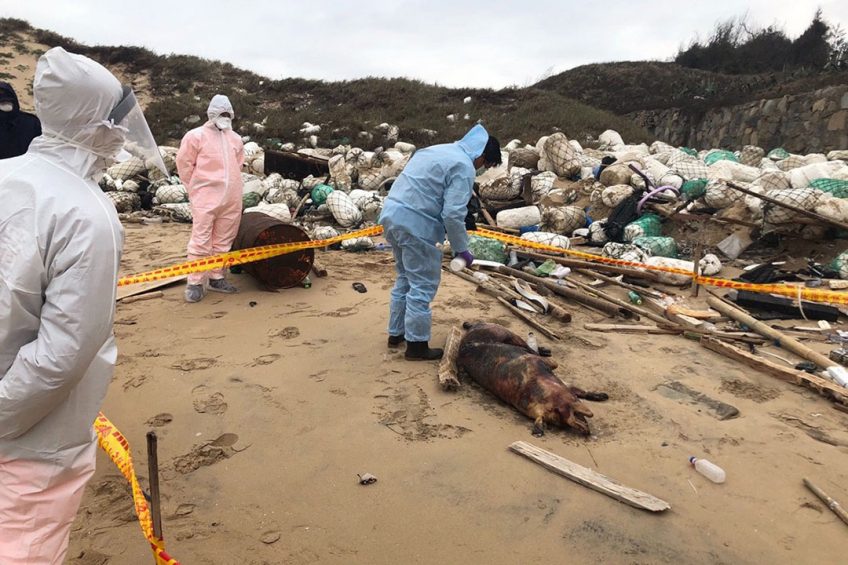What 1 pig can tell about ASF in China

The situation of African Swine Fever (ASF) in China appears out of control. Continental Asia will have to get used to the fact that the virus will be around for much longer. Pig Progress editor Vincent ter Beek explains why and discusses the longer-term consequences.
Kinmen Pig was found on a beach on the island of Kinmen, on New Year’s Eve of 2018. Many pictures were circulated on the Web. They show the animal lying on its right side, among pieces of wood, bottles and fishing nets, I’d say it was about 4-5 months old. Part of its skin had turned black. The carcass was surrounded by men in white and blue biosecurity suits.
Samples were tested in a lab. A few days later, it was announced that Kinmen Pig had died of African Swine Fever. Worth noting is the following: Although located just 6km off the coast of mainland China, administratively Kinmen Island belongs to Taiwan.
Visiting pig farms in the immediate surroundings
Immediately after the finding, the Taiwanese authorities visited pig farms in the surroundings at Kinmen Island. There were quite a few of them. The authorities stated that all farms tested negative for ASF. All in all, the most logical conclusion appears that the animal must have washed ashore.
So where did it come from? As you can see below, opposite Kinmen Island is the city Xiamen, a metropolis with 3.5 million inhabitants. Xiamen belongs to Fujian province, which at that time had reported 3 outbreaks of ASF. Closest by, about 100km in a straight line to the north east, a 4,500 head pig farm near Putian was reported infected on November 6. Now that is quite a distance to float.
I conclude either the animal ended up in the water some 100km south from where it was kept – or there was a disease outbreak on the mainland much closer to Kinmen Island we don’t know of.
ASF virus can contaminate other pigs
One other question that has been puzzling me for some time. ASF is known to be contagious when pigs or wild boar come in contact with infected carcasses. So upon the discovery of ASF, there are a range of steps that need to be taken that ensure carcasses are incinerated or buried professionally to make sure that all contagious particles have disappeared. On top of that, the site where the carcass was found needs to be thoroughly disinfected. Throwing it into a river or the sea, on the other hand, means taking the risk of infecting the surroundings. So why was Kinmen Pig disposed of into the water?
I can think of 3 ways to explain that:
- That person did not know the pig had ASF;
- That person did know it was ASF but had no clue how to dispose of it properly;
- That person did know it was ASF, understood the risks, but did not care.
This is where my line of thought stops – it will be impossible to figure out which of the 3 was true. What is worrisome, though, is that all 3 scenarios are as likely – and none of them would I call optimistic. Every day, contacts inform me about the current situation in China – the gist of all these messages is that the situation is considerably worse than the purple dots on the Pig Progress map indicate. The purple dots follow official reports to the World Organisation for Animal Health (OIE).
Not caring enough about ASF – the consequences
People not knowing, people not knowing enough, and people for whichever reason not caring about the consequences of their actions… What it all led to?
In countries surrounding China and beyond, people have been caught at (air)ports bringing in pork which had been contaminated with ASF – this also included Thailand and Australia.

Since early this year ASF has also been confirmed in pig in Mongolia and Vietnam, the latter being pork-loving to the max as well.
News agency Reuters reported recently that prices for shares of stock-listed pork companies have risen strongly as investors bet on tightening pork supplies.
Plenty of pictures and videos circulate on social media which I choose not to share. They generate an image which is dark and grim. People are dumping dead pigs at the road side, putting live pigs on fire or burying them by the thousands. Of course one could say these show footage that was shot in different years, in a different country or in a different context – but the fact that new footage just keeps coming makes me fear what we are looking at is ASF in China, 2019.
In short, the world’s number #1 pork giant China managed to get ASF endemic in a matter of months.
Official ASF death counts
With that at the back of our minds, let’s take a look at the official count at the OIE. In total 115 outbreaks are now known in 29 provinces, with roughly 475,000 pigs having been killed or culled on farms affected by ASF. In a wider attempt to stop the virus from spreading, the total amount of pigs culled is 950,000 according to the most recent FAO estimate. That is as many pigs as there are humans living in Canada’s capital Ottawa.
These are only official numbers. It’s impossible to guess what we don’t know, but with ASF in smaller and bigger farms, and in wild boar as well, it is safe to say that ASF will not be leaving Asia anytime soon.

Read more about African Swine Fever and other swine health issues in the Pig Progress Health Tool
Needed: Pig people who know and care
That is a paradigm shift for the authorities in not only China, but also in surrounding Asian countries. In the next few years, pig production will have to go through a profound change. In a market with high demand like China, what is needed are pig caretakers with knowledge and who care. This will lead to a transformation where backyard farming will be on its way out.
For now, Japan, the Philippines, Taiwan and Indonesia should bless the sea which is separating them from the continent. For Vietnam I fear that ASF will soon be all over the country.
Opportunities due to ASF for the rest of the world
For the rest of the pig producing world, ASF in Asia will provide opportunities. The United States, Canada, Brazil, Russia, Chile and many EU countries will be ready and happy to supply the pork void on the Chinese market. On top, foreign technologies, ideas and concepts of biosecurity will find their way to China to professionalise the pig producing business.
For Kinmen Pig this all comes too late. Yet we have to thank the animal posthumously. In a way, the death of 1 pig can be a symbol for a large share of 450 million others. Its death allows us, from a distance, to start to grasp what is going on.











